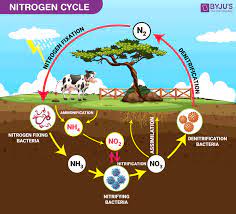
by Bill Schlesinger
(Title from Canterbury Tales, Geoffrey Chaucer, circa 1385
Most of the human body that is not bone is composed of protein, each built with an array of amino acids that contain nitrogen. Reflecting the homogenization of our diets in the modern world, most of the nitrogen in those amino acids can be traced, isotopically, to the use of industrial nitrogen fertilizer to grow the grains we eat or to feed the animals that we eat.
The advent of synthetic nitrogen fertilizer is often credited with allowing the world population to grow to its present level of about 8 billion, without mass starvation. What is remarkable about the success of industrial nitrogen fertilizer is that using it is so inefficient. Only about 10% of the nitrogen applied to crops makes it to our mouth in foods. The rest suffers a variety of fates—not being taken up by plants, volatilization to the atmosphere, or accumulation in non-food materials (stalks and other crop residues). A huge proportion of the nitrogen applied to crops is lost in the runoff to surface waters, leading to excessive algal blooms—the algae like it, too. I’ve written before about efforts to make the agricultural use of nitrogen fertilizer more efficient. (https://blogs.nicholas.duke.edu/citizenscientist/nitrogen-in-runoff/)
A lot of animal protein is consumed in the developed world, and other world regions are rapidly moving toward diets with more meat. When we eat animal protein, some is assimilated, particularly in growing youth. But, at steady-state, the consumption of protein and its constituent amino acids is balanced by nitrogen excretion in urea. Other plant nutrients such as phosphorus and potassium are also excreted in urine, but with diets rich in meat, nitrogen dominates the losses. The N-P-K ratio typical of urine resembles that of lawn fertilizer.
Recently, I calculated the amount of nitrogen excreted in urea by the population of the United States, now about 335 million folks. At about 11 grams of nitrogen excretion per day, the U.S. population excretes 1.3 x 1012 g of nitrogen per year or 1.3 million tons, largely to fresh waters. This amounts to about 10% of the application of fertilizer N in the U.S., and it results in a colossal effort to remove nitrogen during the treatment of sewage waters.
Just as I was doing these calculations, a paper by Maya Almaraz and her colleagues made a similar calculation of nitrogen excretion based on estimates of protein consumption by U.S. citizens. They derived a remarkably similar estimate—1.33 million tons per year and suggested that this could be halved if we were to change our diets to consume less protein. Additional reductions in nitrogen losses to the environment could be realized early in the food-supply chain, in the form of lower demand for nitrogen fertilizers to grow feed for animals.
Production and use of nitrogen fertilizer is expensive and a significant source of air and water pollution and greenhouse gases in the atmosphere. Capturing and reusing the nitrogen in sewage waters and transitioning to a diet with less meat will increase the chances of a sustainable biosphere.
References:
Almaraz, M., C.D. Kuempel, A.M. Salter, and B.S. Halpern. 2022. The impact of excessive protein consumption on human wastewater nitrogen loading of U.S. waters. Frontiers in Ecology and Environment 20: 452-458.
Bird, M.I., S. A. Crabtree, J. Haig, S. Ulm and C.M. Wurster. 2021. A global carbon and nitrogen isotope perspective on modern and ancient human diet. Proceedings of the National Academy of Sciences, U.S. 118, doi: 10.1073/pnas.2024642118
Galloway, J.N. and E.B. Cowling. 2002. Reactive nitrogen and the world: 200 years of change. Ambio 31: 64-71.
Rose, A., A. Parker, B. Jefferson, and E. Cartmell. 2015. The characterization of feces and urine: A review of the literature to inform advanced treatment technology. Critical Reviews in Environmental Science and Technology 17: 1827-1879
Smil, V. 2001. Enriching the Earth. MIT Press, Cambridge